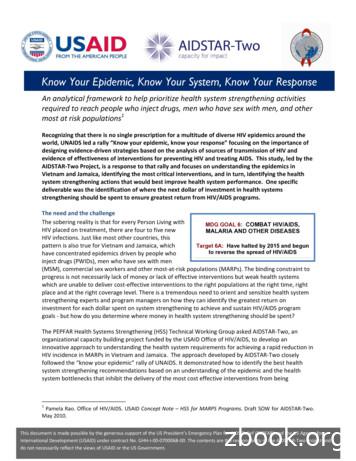Do You Know How - Welcome To NYC.gov
Most New Yorkers who drink do so without negative consequences.But about three out of ten report risky or excessive drinking.It’s important to know how much you are drinking. Here are a few examplesof standard drinks.12 fl oz ofregular beer8 to 9 fl ozof malt liquor(shown in a 12 oz glass) about 5%alcohol content5 fl oz oftable wine about 7%alcohol contentDo you know howmuch you aredrinking?1.5 fl oz shot ofdistilled spirits(gin, rum, tequila,vodka, whiskey, etc.) about 12%alcohol contentabout 40%alcohol content1 bottle of wine 5 drinks.1 pint of beer 1 ¹/³ drinks,so 3 pints 4 drinks.A “fifth” (750 ml) of spirits 17 drinks.Many mixed drinks, such as martinis andcosmopolitans, contain two or threestandard drinks.1
What is low-riskdrinking?4Stay within these low-risk drinking limitsto protect your health.MENWOMENNo more thanNo more thandrinks on any day3AND14drinks on any dayANDNo more thandrinks per week7No more thandrinks per weekSource: NIAAA at s risky drinking?The more drinks you have in one day and themore heavy drinking days you have, the greateryour risk.Risky or excessive drinking increasesyour risk for:Accidents and injuriesCommitting or being the victim of actsof violenceSuicideCancers of the mouth, throat, esophagus,liver, breast and colonHypertensionDepression, dementia and other mentalhealth disorders2
How can youreduce your risk?Even small changes can reduce your risk ofdeveloping alcohol-related problems.Different strategies work for different people.Here are some to try.Stay within the low-risk drinking limits.Take note of how much you drink, and whenand where you drink more.Set a goal for how many drinks you will haveand write it down before you drink.Space your drinks over time and drinknon-alcoholic drinks, such as seltzer or water,in between.Eat food while you are drinking.Get support from friends and/orprofessionals.Get involved in non-drinking activities.Avoid people and settings that triggerthe urge to drink.For some people, any drinking may pose healthrisks, including the following:People who are under 21People who are pregnantPeople who have hepatitis or other liverdiseasesPeople who have an alcohol use disorder3
Why is underagedrinking risky?Underage drinking increases the risk ofdeveloping alcohol use disorders. Nearly halfof people who start drinking before age 14 willbecome alcohol dependent in their lifetimes.Underage drinking is associated with riskybehaviors like unsafe sexual activity, drinkingand driving, and experiencing or engaging inviolent behavior.Each year, alcohol-related injuries cause 5,000deaths among people under age 21 in theUnited States.In 2011, there were nearly 7,000 alcohol-relatedemergency department visits among NewYorkers under age 21.If you are concerned about a friend or familymember, visit samhsa.gov and search underagedrinking prevention for tips and resources.Why is drinkingwhile pregnantrisky?Fetal alcohol spectrum disorders (FASDs) arethe leading preventable cause of intellectualdisabilities and birth defects. One in 100babies is born with an FASD. Undiagnosed,misdiagnosed and untreated FASDs can lead tomore severe learning, behavioral, mental healthand substance use problems.Although not every alcohol-exposed pregnancyresults in a child with an FASD, it is safest to notdrink while pregnant.4
Why is drinkingwith hepatitisor liver diseaserisky?Drinking alcohol when you have heptatitisincreases your risk of developing fibrosis, liverdisease and liver cancer.What is alcoholuse disorder?On the spectrum of risky drinking, alcohol usedisorder is the most severe. Signs include:It’s safest not to drink at all. But any reductioncan still help protect your liver.A strong, irresistible urge to drinkBeing unable to stop drinking once you startBlackoutsThe need to drink greater amounts of alcoholto feel its effectsWithdrawal symptoms, including nausea,sweating, tremors and anxiety, when theeffects of the alcohol wear off.Alcohol use disorder can be treated withmedication, counseling and help groups.How does riskydrinking affecteveryone?5Risky drinking can be costly: it leads to lostproductivity, increased health care, sanitation,and law enforcement costs. It is also a majorcontributor to violence. One in five New Yorkersreported experiencing harm in the past sixmonths due to someone else’s drinking,and nearly half of those who experienced harmwere non-drinkers. Stay within the low-risk limitsto protect yourself and your community.
Is your drinkingputting youat risk?Over the past12 months:Write in your score for each question and addup the total below.01234How often have youhad a drink thatcontained alcohol?NeverOnce amonth orless2 to 4times amonth2 to 3times aweek4 or moretimes aweekOn a typical drinkingday, how manydrinks did you have?1 or 23 or 45 or 67 to 910 ormoreHow often did youhave 6 or more drinkson one occasion?NeverLess thanonce amonthOnce amonthOnce aweekDaily oralmostdailyScoreTotal ScoreFrom: AUDIT-C, a brief version of the Alcohol Use Disorders Identification Test. Available LC.0000164374.32229.A2/pdfYour drinking could be harmful if your total score is:3 or higher for women andpeople 65 or older4 or higher for menIf you are concerned about your alcohol use, talk with a health careprovider about how your drinking may be affecting you.ResourcesVisit rethinkingdrinking.niaaa.nih.gov.Go to cdc.gov and search alcohol useand your health.Visit nyc.gov/health and search alcohol.Call 888-NYC-WELL (888-692-9355)for free and confidential support.6
MHY484002E - 6.17
Do you know how . much you are drinking? Most New Yorkers who drink do so without negative consequences. But about three out of ten report risky or excessive drinking. It’s important to know how much you are drinking. Here are a few examples . of standard drinks. about 5% . alcohol content about 7% . alcohol content about 12% . alcohol .
Although you think you do, you don’t know jack about me. You don’t know the pain, the hate, or the sorrow inside. You don’t know how it feels to have to compete and to constantly have to prove yourself. You don’t know how it feels to battle the stereotypes and the prejudice. You don’t know, or do you
You need to work smarter, not harder. You need to know what you know, and know ZKDW\RXGRQ¶WNQRZ 7KHQZRUNRQ\RXU areas of weakness. Quality, not quantity, is the secret. You need to practise the way you intend to perform on the exam. Example 1.6: 2001 Question 1 (2 m, 46%) A cy
WELCOME The management and staff of the Falls Villa wish you the most cordial welcome. We are pleased to welcome you in our family. We hope that you can feel at home in your new environment. We have developed a welcome guide that will familiarize you with information about your admission and services offered by our nursing home.
If you are happy and you know it, clap your hands If you are happy and you know it, clap your hands If you are happy and you know it, and you really want to show it, If you are happy and you know it, clap your hands (continue with these actions; stamp your feet, turn around, shout hooray)
Old Jim Crow don't you know It's all over now Old Jim Crow You've been around too long Gotta work the devil 'Til your dead and gone Old Jim Crow Yes, don't you know It's all over now It's all over now Old Jim Crow You know it's true When you hurt my brother You hurt me too Old Jim Crow don't you know It's all over now Old Jim Crow
Get out of your own way and be genuinely you “Faking it” makes everyone uncomfortable Learn and grow, don’t copy “You know what you know what you know” Don’t try to project or act in your interview (I know they try to coach otherwise) It’s OK to say, “I don’t know, but
1 Pamela Rao. Office of HIV/AIDS. USAID Concept Note . Everybody’s Business 2007 4 Know your Epidemic, Know your System, Know your Response various governmental and nongovernmental agencies, groups which have access to health care and the means by
Understand what an operating system is and the role it plays. Know and identify Windows 7 desktop components Know and apply how to open and explore the control panel. Know and apply how to personalize the desktop. Know and identify the components of a window. Know and apply how to manage multiple windows and multiple monitors. Know and apply how to change the date .























